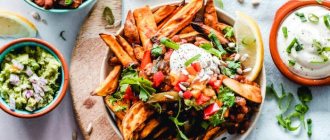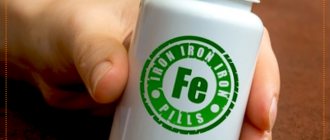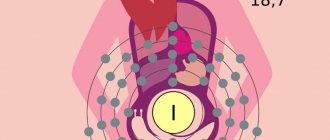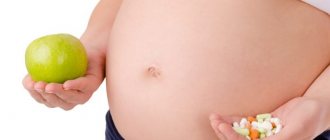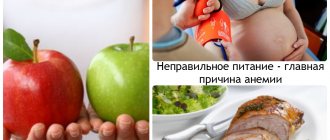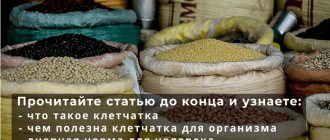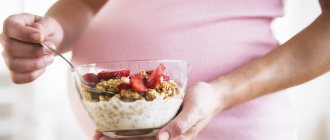One of the most common complications during pregnancy is iron deficiency anemia. The main function that iron performs in the human body is to transport oxygen to the tissues of the body. During pregnancy, the body's need for oxygen increases; with an unbalanced diet, chronic oxygen starvation develops against the background of a reduced hemoglobin content in the blood. The building block for the hemoglobin protein is precisely the microelement iron, so iron is in great demand in the body during pregnancy.
The role of iron in the human body
Ferrum is found in the human body in the following systems:
- blood;
- Bone marrow;
- spleen;
- liver.
About 80% of iron is in the form of hemoglobin in red blood cells, on average 20% in reserve and 1% in respiratory enzymes.
The main role of iron is the formation of hemoglobin. It is also involved in the production of thyroid hormones. Iron helps protect the body from bacteria; it is involved in the formation of immune cells.
Iron ensures tissue respiration processes. It improves the effect of B vitamins on the body. Iron is part of enzymes that control DNA synthesis, cholesterol metabolism and energy metabolism between cells.
Iron requirements vary depending on age and health status.
Iron in foods for pregnant women table. List of foods rich in iron for pregnant women
Quite often, a pregnant woman is diagnosed with iron deficiency anemia. With this disease, the expectant mother experiences severe weakness, and her health deteriorates significantly. In order to increase the iron content in the body, you need to take special medications. When used correctly, these medications do not have a negative effect on the fetus.
The role of iron in the body
The human body contains approximately 4 grams of iron. It is found in the blood, spleen, muscle tissue, liver and bone marrow. The role of iron is difficult to overestimate. This substance enriches the tissues of the human body with oxygen, takes part in energy metabolism, and strengthens the immune system. Iron supports normal brain and thyroid function.
Iron-rich foods
Iron-rich foods include organ meats and seafood (mussels, shrimp and oysters). The trace element is found in dried white mushrooms, red beans, peas, soybeans, lentils, carrots, and potatoes. Among the berries and fruits, apples, bananas, blueberries and strawberries stand out. They contain large amounts of iron. A pregnant woman needs to create a balanced menu for every day. It is important to properly combine a variety of foods. Substances such as vitamin C and folic acid speed up the absorption of iron. Therefore, a pregnant woman is recommended to eat a fruit salad consisting of apple, orange and banana. Meat dishes should be served with potatoes or boiled cauliflower as a side dish. Calcium interferes with the proper absorption of iron. Therefore, foods high in iron and dairy products should be eaten at different times.
When drinking coffee or tea, the absorption of iron also slows down. Therefore, these drinks should be drunk no later than thirty minutes after eating. Coffee or tea can be replaced with compote made from dried fruits, drinking water or vegetable juice.
Chicken liver for expectant mothers
A pregnant woman should cook chicken liver dishes. It protects the body from the harmful effects of heavy metals. In addition to iron, which increases hemoglobin, the product contains the following substances:
- choline It helps improve brain activity, strengthens memory; riboflavin. This substance helps iron to be absorbed quickly;
- selenium. This substance improves the functioning of the thyroid gland;
- heparin. This substance normalizes blood clotting;
- vitamin C. It improves the condition of hair and skin, strengthens vision.
Chicken liver contains quite a lot of folic acid. This substance takes part in the formation of the immune and circulatory systems of the fetus and prevents the occurrence of birth defects.
A pregnant woman can prepare this simple dish:
- It is necessary to clear 500 grams of liver from the veins.
- The offal is cut into neat slices and rolled in flour.
- Chicken liver should be fried in olive oil on both sides until a crust forms.
How to determine iron deficiency in the body
Iron deficiency is manifested by the following symptoms:
- fast fatiguability;
- weakness;
- headache;
- depressive disorders;
- excessive nervous excitability;
- rapid pulse;
- a feeling of tightness or pain in the heart area;
- rapid breathing;
- discomfort in the intestines;
- changes in taste buds;
- decreased appetite;
- dry mucous membranes;
- cold intolerance;
- memory loss;
- brittle and thin nails;
- spots in the eyes;
- hair loss;
- unhealthy pale skin;
- frequent colds.
Our body cannot synthesize iron; it only processes this element, extracting it from worn-out red blood cells.
With iron deficiency, hemoglobin levels decrease, so a complete blood test will help to accurately establish the diagnosis. If you notice one of the symptoms of ferrum deficiency, contact your doctor, who will issue a referral for a blood test. The hemoglobin level determines whether iron intake is normal.
What reasons lead to a decrease in iron
Most often, an unbalanced diet leads to anemia. A deficiency in the body of B vitamins, folic acid, vitamin C, copper, and cobalt leads to a decrease in iron. During pregnancy, the need for iron increases and the volume of circulating blood increases. The microelement is also necessary for the fetus to develop properly.
Gastrointestinal disorders are also factors of low hemoglobin. This is also caused by diseases characterized by impaired absorption of microelements.
Excess
Deficiency is more common, but excessive amounts of the element in the body are not uncommon. Both options have a negative impact on health.
An excess may indicate diseases of the spleen or liver, as well as problems with metabolic processes. But more often this is a consequence of poorly purified water.
You may notice the following symptoms:
- problems with the gastrointestinal tract (constipation, diarrhea, nausea, vomiting);
- headaches, often loss of consciousness;
- the appearance of spots on the skin.
If you do not start treating this immediately, complications such as diabetes, arthritis, liver disease, and cancer are possible. In this case, only a specialist can prescribe treatment.
Product Compatibility
To increase the absorption of iron from foods, it is important to know about their compatibility. Trace elements can increase or decrease the absorption of ferrum. With a properly selected diet, which takes into account the compatibility of products and the interaction of vitamins and minerals, pregnancy and fetal development will go well. From time to time, pregnant women need to undergo a general blood test in order to adjust their diet in time or decide on taking medications.
Just because you eat foods that contain iron doesn't mean you have enough.
Iron-rich foods for pregnant and lactating women:
- beef:
- mutton;
- lean pork;
- animal liver;
- fish;
- seafood;
- caviar;
- eggs of any birds;
- cereals (buckwheat, oatmeal, rye);
- spinach;
- cabbage of all kinds;
- pomegranate;
- plum;
- persimmon;
- apples;
- strawberry;
- prunes;
- dried apricots;
- figs;
- nuts;
- seeds.
Although the iron content of some plant foods is high, the non-heme form of iron is poorly absorbed.
Products that help in the absorption of ferrum
In addition to foods containing iron, substances are needed that help it be better absorbed:
- ascorbic acid helps not only to better absorb ferrum, but also improves the functioning of the endocrine and nervous systems, stimulates good hematopoiesis;
- vitamin B12, often the root cause of anemia, is involved in many processes;
- folic acid, necessary for normal cell division, improves appetite.
List of foods that help iron be better absorbed:
- cabbage (cauliflower, Brussels sprouts, broccoli, white cabbage);
- cranberry;
- citrus fruits (oranges, tangerines, lemons, grapefruits);
- a pineapple;
- papaya;
- strawberry;
- melon;
- kiwi;
- rose hip;
- black currant;
- Rowan;
- sea buckthorn;
- red bell pepper;
- horseradish;
- parsley;
- green onions;
- dill;
- dairy products;
- eggs;
- seafood;
- seaweed;
- potato;
- eggplant;
- zucchini;
- spinach;
- corn;
- wheat sprouts;
- garlic;
- blackberry;
- strawberries;
- viburnum;
- gooseberry;
- apricots;
- pears;
- cherry;
- carrot;
- pumpkin.
Our body perceives iron best from meat (on average 20% is absorbed), a little worse from fish and seafood (about 11%), legumes (7%) and nuts (6%). Only 1-3% of iron is absorbed from fruits, vegetables and cereals.
Animal protein helps iron from food to be better absorbed. Scientists have not yet fully established how iron absorption and animal proteins are related, so they simply called it the meat factor.
Fermented milk products also contribute to better absorption of iron from food. This occurs due to an increase in the solubility of ferrum compounds.
Products that interfere with the absorption of ferrum
Oxalic acid and tannins reduce the absorption of the microelement, so sorrel and blueberries should not be consumed in large quantities if you are anemic. Phosphates, phytates and phytins, which are found in grains, legumes and some vegetables, also reduce iron absorption. Soy protein and dietary fiber, especially bran, also reduce the availability of iron for the body.
Tea, coffee, cocoa and other drinks containing caffeine block the absorption of ferrum. If you take additional vitamin complexes with calcium, keep in mind that this element also interferes with the absorption of iron.
Do I need to take additional iron supplements?
Whether or not to take medications or vitamin complexes with iron is decided by the attending physician based on tests. The dosage is determined based on hemoglobin levels in a general blood test.
To improve the absorption of iron, it is also important to receive the right amounts of vitamins and minerals, which play the role of catalysts and help this element to be absorbed.
Iron absorption is determined based on intermediate tests during treatment. If necessary, the dosage is adjusted or the drug is changed. There are two types of iron in preparations: divalent and trivalent. What kind of iron is needed is determined by the attending physician individually in each case.
Iron in Pregnancy Foods: Best Sources
Pregnancy is a time when the need for nutrients increases significantly as the baby receives the necessary resources from the mother's body. When the set of nutrients is depleted, it is replenished directly from the diet, but if the nutrition is inadequate, the expectant mother runs the risk of many diseases.
One of the most common is anemia observed with iron deficiency, in this case, sources of iron for pregnant women and not only will help correct the situation.
Lack of the mineral can cause miscarriage, premature birth and low birth weight, which is why optimal levels are so important. A well-absorbed form of iron is obtained from animal products, mainly eggs and beef, from where the mineral is absorbed regardless of whether it is needed at the moment or not, but it is worth remembering the norm.
An excess of this element accelerates aging, increases the manifestation of heart and liver diseases, and therefore, most experts recommend plant sources of iron, by receiving which the body itself “decides” what it needs first.
Pregnant women are recommended to consume up to 27 milligrams of iron each day.
In addition, animal products are consumed much more often than plant products, while the preponderance should be in favor of greens, vegetables and fruits, which have a positive effect on overall health. Products containing a lot of vitamin C, for example, citrus fruits, parsley, chickpeas, will help increase the absorption of plant iron by 2-4 times. When increasing the level of a mineral, it is better to limit (not refuse!) the consumption of milk and cheese, which have a negative effect on the absorption of the element.
The best sources of iron in foods for pregnant women
The information below is taken based on 200 grams of product, that is, an average portion.
Legumes
Legumes are an excellent option, as are the dishes produced from them. Tofu made from soy contains about 8 mg of iron. In addition to the mineral, soybeans offer up to 19 grams of protein per three-gram serving. Lentils provide 6 mg, as well as fiber, protein, complex carbohydrates, and folic acid, which is important for fetal development.
Ready-cooked lentils contain 18 grams of protein and half the daily value of fiber. In third place are beans, which contain 4–6 mg of the substance, and chickpeas offer the same amount.
Nuts and seeds
Pumpkin seeds, sesame seeds, and flaxseed are the richest sources of iron, containing about 1 - 3 mg per tablespoon. Ready-made “dishes” from seeds such as tahini (2.6 mg), hummus (3 mg) are also welcome. These seeds also contain protein, fiber, magnesium, selenium, calcium, omega 3, zinc, and antioxidants.
Among the nuts that help cope with anemia are almonds, cashews, pine and macadamia, which contain almost 2 mg of the essential mineral per 30 grams of chopped nuts. Please remember that blanching or baking reduces the nutritional value, so it is best to eat them raw.
Vegetables
Although vegetables are not particularly valued as a source of iron during pregnancy, they do store a lot of vitamin C, which improves the absorption of the mineral. First of all, you should pay attention to spinach, parsley, cabbage, chard and turnip leaves (2.5 - 6.4 mg). The most attractive is spinach, 100 grams of which provides more iron than the same amount of salmon or red meat. Fresh broccoli and Brussels sprouts contain up to 1.8 mg.
Tomatoes belong to the useful category, but they bring more benefits in the form of a concentrated paste, which is almost 4 mg. This vegetable perfectly complements the other vegetable components of the menu for anemia, since it is rich in vitamin C. Potatoes contain enough iron, but they are concentrated mainly in the peel. One large, unpeeled potato weighing 300g delivers 3.2mg of the mineral.
Fruits
Dried plum is known for its mild laxative effect, which helps relieve constipation if it bothers a pregnant woman, in addition, the fruit supplies 3 mg of iron with vitamin C. Olives also belong to the fruit family because the seed is in the center. The mineral content is quite high - 3.3 mg per 100 g.
We recommend: nutrition for pregnant women with anemia
Cereals
Cereals, unfortunately, almost completely lose their beneficial properties after cooking, so we will consider only those that retain the greatest amount of iron. These are amaranth 5 mg, oats 3 mg and quinoa 2.8 mg. In addition to fighting anemia, they perfectly support the immune system thanks to magnesium, zinc, selenium and B vitamins. Oats reduce cholesterol and blood sugar levels and are recommended for pregnant women with gestational diabetes.
Iron in foods for pregnant women is very important; it helps maintain immunity, good mood and expect the baby without unnecessary worries. Proper nutrition is the key to having a smart and healthy child.
What affects iron absorption
When the acidity of the gastric juice decreases, for example when taking antacids, the absorption of iron decreases.
The body's absorption of iron is affected by:
- malnutrition (inadequate nutrition, incompatibility of food products, diets, starvation);
- digestive tract disorders associated with malabsorption of nutrients;
- dysregulation of vitamin C metabolic processes;
- lead poisoning;
- taking antacids;
- gastritis with low acidity;
- dysbacteriosis;
- Crohn's disease;
- enteritis;
- cystic fibrosis;
- cancer;
- worms.
If a person lacks vitamin A, then iron will not be absorbed and used to “build” new red blood cells.
For diseases characterized by a decrease in iron absorption, it is necessary not so much to increase the dose of ferrum as to solve the main problem. Products high in iron in cases of diseases accompanied by impaired absorption of microelements will not be beneficial until the root cause is eliminated.
Properties
Iron has the following beneficial properties for the human body:
- participates in the creation of red blood cells, which in turn remove carbon dioxide and provide cells with enzymes, ions and molecules;
- participates in the creation of immune cells, so it is almost impossible to fight diseases without it;
- the functionality of B vitamins depends on it;
- maintains bactericidal properties of blood;
- participates in the synthesis of connective tissues and some transmitters of brain impulses.
Thanks to normal levels of this microelement, we feel tired more slowly. The tone of the skin and the beauty of hair and nails also depend on it.
First of all, iron prevents blood diseases, such as anemia. But the entire body as a whole can suffer from a lack of an element - it simply cannot resist bacteria and viruses.
Important! Even the most high-quality and thoughtful diet allows the body to receive no more than 20% of the daily norm of this microelement.
The body's daily requirement for iron
For mature women, 18 milligrams of ferrum per day are needed for normal life. This applies to women of childbearing age who are menstruating. Every month during menstruation, women lose iron through their blood. Older women after menopause need 10 milligrams of iron per day.
For men, the daily requirement for iron is less - 10 milligrams.
Side effects in case of overdose
With excess iron, the following symptoms are observed:
- headache;
- dizziness;
- hypotension;
- vomit;
- diarrhea;
- inflammatory processes in the kidneys.
Many orange and yellow fruits and vegetables are rich in vitamin A - it is this substance that gives them their cheerful colors.
Iron deficiency anemia: signs, risk factors and impact on the child.
If there is not enough iron in the body, anemia may develop. During pregnancy, its severe form increases the risk of premature birth, low birth weight, and postpartum depression. Some studies also show an increased risk of infant death immediately before or after birth.
You are at increased risk of developing anemia during pregnancy if:
- the interval between pregnancies was short;
- multiple pregnancy;
- frequent vomiting due to toxicosis;
- do not consume enough iron in food;
- before conception, menstrual flow was very heavy;
- There was a history of anemia before pregnancy.
Signs and symptoms of iron deficiency anemia include:
- fatigue;
- weakness;
- pale or yellowish skin;
- intermittent heartbeat;
- shortness of breath;
- dizziness;
- chest pain;
- cold hands and feet;
- headache.
Keep in mind that symptoms of anemia are often similar to common pregnancy symptoms. Regardless of whether you have any symptoms, blood tests will be taken to detect this condition.
Percentage of iron absorption from foods
During pregnancy, the body needs additional sources of ferrum. You can compensate for the deficiency by eating foods rich in iron, as well as foods that help it be better absorbed.
Ferrum in food is divided into heme and inorganic. The first can be obtained from products of animal origin, the second - from plant origin. Heme iron is absorbed better, so it is recommended to include red meat, offal, fish, seafood and eggs in the menu of women carrying a child. But you shouldn’t overeat iron-containing foods either, so as not to gain weight during pregnancy.
Bioavailability, that is, absorption by the body, differs between different forms of ferrum. The absorption of iron from animal products is higher, 20-45% is absorbed in the intestines, inorganic - 10%. To increase the bioavailability of the microelement, it is necessary to adjust the diet by introducing foods that increase the absorption of ferrum.
Combination rules
Which foods contain a lot of iron - knowledge that helps when creating a daily menu. It is important to pay attention not only to the amount of iron contained, but also to the amount of other elements, especially those that the body needs for its normal functioning.
It is important to remember: different elements can interact with each other, as a result of which their beneficial effects can be enhanced. But it is possible that when interacting with other substances, iron, on the contrary, will lose its beneficial properties and, possibly, cause harm to the body.
Iron is best absorbed and digested in the intestines if it is present:
- vitamin B12;
- vitamin C;
- folic acid;
- organic acids.
It is recommended not just to consume iron-containing foods such as an apple, but to combine them with foods rich in, for example, vitamin C. An example of a competent combination of 2 fruits is an apple and an orange. The first contains a lot of iron, and the second contains a lot of vitamin C.
For the same reason, meat that contains iron is best eaten with a vegetable side dish, for example, made from cauliflower or potatoes. However, not all elements have a positive effect on the process of iron absorption. There are also those that, on the contrary, prevent its normal absorption. The main “enemy” of iron should be considered calcium.
Avoid consuming iron-containing foods and calcium-rich foods at the same time. The latter includes milk and everything prepared on its basis. Oxalic acid also prevents the rapid absorption of iron. Tannins cause a similar effect.
You should not consume iron-containing foods at the same time as tea and coffee, or drink them 30 minutes after eating iron-rich foods. Otherwise, such an important element simply will not be absorbed. For prevention, vitamin and mineral supplements can be taken along with iron-containing foods. However, their selection should only be done with a doctor.
Daily iron requirement for anemia
When diagnosed with iron deficiency anemia, doctors recommend consuming twice the normal amount of ferrum. The need for iron increases sharply in women during the postpartum period. This is associated with blood loss during childbirth and postpartum hemorrhage. Women outside of pregnancy need at least 18 milligrams, during pregnancy - at least 30 milligrams. With anemia, the need doubles, in severe cases - triples. If there is severe birth blood loss, ferrum may need to be administered intravenously. The correct dosage is selected by the attending physician based on test results.
Folic acid helps with iron absorption and normalizes the digestive tract, and healthy digestion is essential for the absorption of this element.
In case of anemia, foods rich in iron may not cover its deficiency, so doctors prescribe medications and dietary supplements with iron.
What iron in foods is needed for anemia
If, based on the results of a general blood test, the doctor has diagnosed anemia, you need to adjust your diet.
When hemoglobin levels are low, the diet focuses on the following foods:
- red meat;
- offal;
- eggs;
- caviar;
- seafood;
- beet;
- fish;
- apples;
- citrus;
- seaweed;
- pomegranate;
- strawberry;
- nuts;
- prunes;
- peaches;
- cabbage;
- leafy vegetables.
The more variety of products you use in cooking, the less likely you are to become deficient in iron or any other trace element or vitamin.
What is the best way to absorb iron?
To ensure that the element is preserved in foods, use them in combination with vitamin C, which is abundant in citrus fruits, greens, tomato juice, sweet peppers, etc. Vitamin B helps the absorption of iron. It is contained in mushrooms, cabbage, seaweed, carrots, melon, and leafy vegetables .
Folic acid goes well with the element. Its sources are grain bread, corn, rice, oatmeal, and cereals.
Some foods reduce iron intake. For example, those that contain a lot of calcium - dairy drinks, cocoa, cheese. Take them separately from micronutrient-rich meals or snacks.
Daily iron requirement during pregnancy
During gestation, the body's need for iron increases by 15 milligrams and amounts to 30-33 milligrams per day. To maintain hemoglobin levels at the required level, women are advised to adjust their diet by increasing the amount of foods that improve the absorption of ferrum (fresh vegetables and fruits).
At the first signs of anemia in pregnant women, the dose of ferrum is doubled, that is, to 60 milligrams. Iron in foods for pregnant women with low hemoglobin will not be able to provide such an amount of microelement, so preparations with iron are prescribed.
Iron deficiency in pregnant and lactating women
With a lack of iron, pregnant women may develop weakness, headaches and digestive disorders. Since iron is involved in the construction of certain parts of the brain, its deficiency during fetal development can lead to cognitive and intellectual impairments in the infant.
The same applies to ferrum deficiency in infants of the first year of life. If a breastfeeding woman eats poorly and does not take iron supplements, the child may experience mental and psychomotor development delays.
Fatty and fried foods, ready-made oily sauces such as mayonnaise, hot spices and marinades should be avoided
With a deficiency of hemoglobin in pregnant women, tissue hypoxia occurs - oxygen starvation of cells, including the fetus. Therefore, it is important to include in the menu foods that contain a lot of iron for pregnant women and foods that improve its absorption.
Frequent complications of ferrum deficiency in pregnant women:
- risk of miscarriage;
- gestosis;
- hypotension;
- placental abruption;
- fetal development disorders;
- premature birth;
- anemia in a child;
- disorders in the psychophysical development of the child.
Prevention of anemia is much more effective than its treatment, especially in pregnant women. Therefore, it is important at the pregnancy planning stage to monitor hemoglobin levels and bring them back to normal. The greatest benefit will come from a balanced diet during preparation and during pregnancy. During pregnancy, as a reminder, you can print out a table with a list of foods rich in iron and create a menu from them to avoid a decrease in hemoglobin levels.
The role of the trace element
One of the most important minerals is iron. Iron-containing products are involved in hematopoiesis and the synthesis of red blood cells, providing the body with oxygen, which is vital for a pregnant woman and the developing fetus. By consuming insufficient amounts of iron in food during pregnancy, the expectant mother experiences:
- headache;
- constant fatigue;
- oxygen starvation;
- iron deficiency anemia develops.
The child may also experience oxygen starvation, which negatively affects his condition.
Avoiding negative consequences is not so difficult; it is enough to take the required amount of foods containing large amounts of iron.
Do I need to take iron supplements during pregnancy?
According to WHO, it is recommended that pregnant women take oral supplements containing 30-60 mg of elemental iron (or equivalents) daily to prevent anemia.
The issue of the effect of iron-containing drugs on the outcome of pregnancy and childbirth has been studied repeatedly. One of the largest studies, completed in 2013 in the UK, confirmed that daily iron supplementation during pregnancy increased maternal hemoglobin, halved the risk of anemia and significantly improved birth weight in a dose-dependent manner, leading to a reduced risk of having a small child. weight (the weight of children increases by an average of 41.2 g at birth, and the risk of having a child with low body weight is reduced by 19%).
On the other hand, there are more than 60 studies involving more than 40,000 women, the results of which show that if a pregnant woman has normal iron levels, taking 30 mg of the trace element per day as a preventative measure will not provide significant health benefits for either her or her mother. fetus Although iron supplements have been found to reduce the risk of anemia, they have no effect on the rate of preterm births or the number of low birth weight (less than 2,500 grams) babies.
In most cases, you will get enough iron by taking prenatal vitamins, since many types contain the recommended amount of the mineral. Your doctor will check your iron levels periodically, depending on your test results and whether you are a vegetarian. If levels are low, additional mineral supplementation may be required.
Consumption rate per day
If you have anemia, you need to replenish your blood with hemoglobin; each situation has its own daily requirement. It is diagnosed by a hematologist.
The daily allowance for children corresponds to their age - the older they are, the more is required. You need approximately 5-15 mg of microelement per day.
The norm for females is about 20 mg, provided proper nutrition and a healthy lifestyle. When carrying a baby or breastfeeding, the indicators are higher, because a lot of vitamins are spent on the formation of the fetus, the norm rises to about 30 mg.
The norm for males is less - 10-15 mg per day. You need to increase it against the background of intense physical activity, in case of abuse of bad habits.
Pregnant
The daily norm of pregnant women depends on the iron levels at the moment. Different for different periods:
- Weeks 1-13 – 14 mg,
- 14-27 weeks – 20-30 mg,
- Week 28-40 – 33-35 mg.
Causes of deficiency
During pregnancy, iron is spent on the woman's hematopoiesis processes and the needs of the fetus. This is especially noticeable from the 16th week, when the process of hematopoiesis in the baby begins. At the end of the period, iron reserves become minimal; full recovery will take 2-3 years.
Also, the causes of anemia in pregnant women can be:
- iron deficiency (lack of meat products),
- lack of vitamins B, C – important for proper absorption of iron,
- diseases characterized by a lack of protein necessary for iron metabolism, this also includes severe forms of gestosis,
- toxicosis - gestosis in the early stages (prevents a woman from eating properly),
- frequent births with a small interval.
Risk groups for anemia include:
- multiple pregnancy,
- women who gave birth a lot and often,
- women with prolonged menstruation before conception - more than 5 days,
- patients with symptoms of anemia during a previous pregnancy,
- gestosis,
- chronic pathologies of the gastrointestinal tract, liver, infections,
- vegetarianism.
Helpful advice! All women at risk need to closely monitor their health and carry out mandatory anemia prevention while carrying a child.
Menu
An approximate menu for a pregnant woman with low hemoglobin looks like this:
- Breakfast: 2 eggs, millet porridge with butter, juice.
- Snack: 200 ml apple juice, 100 g cottage cheese or vegetable salad.
- Lunch: 300 g of soup with sour cream, boiled meat, 200 ml of rosehip decoction.
- Snack: milk with crackers.
- Dinner: a glass of kefir and dried fruits.
The specified nutrition or something similar will speed up the processes of restoration of vitamins lost by the body.
Kefir with dried fruits
What to consider when planning your diet
First of all, the compatibility of products is taken into account. It is important to note that the element is absorbed differently in all products. It is found in meat and red fish in the form of hemoglobin, which means it is easier to digest. Plant foods contain iron outside of the hemoglobin protein, so you will need much more of this food.
A significant iron deficiency requires taking medications in addition to diet. It is especially dangerous to neglect this disorder during pregnancy. It is extremely important to regularly take tests for hemoglobin and visit a gynecologist.
